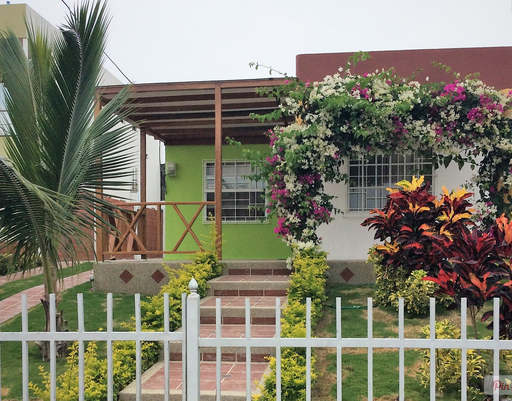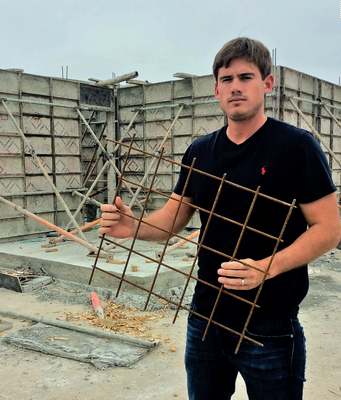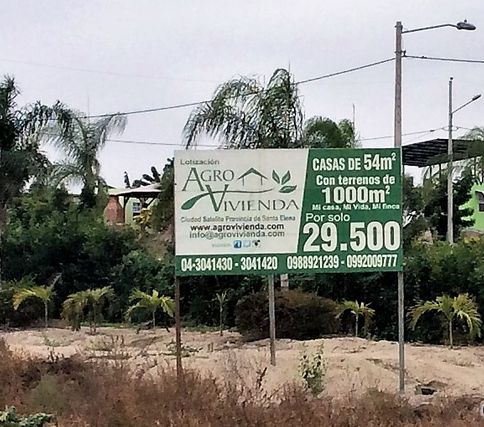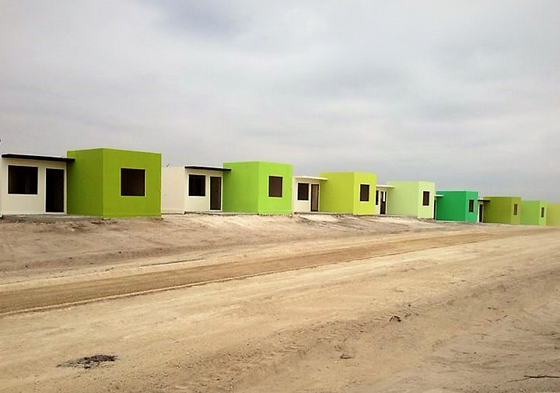Agrarian urbanism, Ecuador style: $29,500 for a home with a big garden plot out back
By Fernando Pagés Ruiz
The first thing that strikes you about the prominent billboard, when you make the turn onto Via a la Costa — the highway to the coast — that takes you from Guayaquil to the beach resort towns along the Pacific shoreline of Ecuador, is the price: $29,500. All in, for a brand-new home.

A home in Agro Vivienda.
Next, you puzzle at the name of the development: Agro Vivienda, or “Agro-Habitat.” What does that mean?
In the United States, the concept of agrarian urbanism has taken hold among New Urbanist developers. The self-described New Urbanists popularized those neotraditional neighborhoods popping up all over America. New Urbanists define “agricultural urbanism” as a method of design that incorporates agricultural activity to promote the economic, environmental, and social benefits of local food cultivation from a neighborhood’s core to its rural edge.
It’s a very high-minded idea, with complex implications that essentially involve neighborhood-based community gardens and some light, boutique farming if there’s a rural edge to the community.
It’s an idea that appeals to the affluent and educated, whose means have changed, but not their values — the same folks that buy Volvos and Subarus. You won’t find homes under half a million, let alone under $30,000, in the agrarian neighborhoods of the U.S.
Real agro-urbanism for real people
Another thing you notice as you drive from Guayaquil to the beaches, about two hours west of the city, are the vendors along the roadside. In the absence of a strong economic safety net, poor Ecuadorians must work. Since jobs are not as plentiful as people, poor Ecuadorians become entrepreneurs, selling everything from peeled oranges to chilled coconuts, and even homemade concrete blocks, in lean-tos and front yards on either side of the road. That’s where the idea for Agro Vivienda — a low-cost, agricultural community —came from.

Builder Chris Gloc shows how the houses in Agro Vivienda are built.
Carlos Palau, a civil engineer, owned 640 hectares of family land about 30 minutes from the coast of Ecuador, and he wanted to develop it. On a vacation in south Florida, he found inspiration for the neo-agrarian way of life on a strawberry patch, where he and his family picked their own berries to have them made into shakes at Knauss Berry Farm, near Homestead.
Carlos had heard about agricultural urbanism, and began to think about how his own family, of Polish decent, had always enjoyed a small garden and picked their vegetables, raised chickens, and sustained themselves through light agriculture — the original urban agriculture. Nowadays, even in his native Ecuador, people needed money as well as vegetables and chickens. Not only to feed themselves, but to own land and a house to live in. At the Knauss Berry Farm, the owners seemed to have found a solution to turning agricultural land into both self-sustaining food and money.
Allowing his muse to meditate on the family land in Ecuador, suddenly the engineer snapped on an idea: Subdivide his family land into plots large enough to farm short-cycle crops, like watermelon. Then build and sell homes on those plots at a price that crops could sustain. In other words, with mortgage payments of about $150, which a stand at the side of the road — selling watermelons, papayas, maracuja, or starfruit — could bring in reliability.
That’s how the idea for Agro Vivienda was born: the land would pay for itself. The next challenge was how to build homes that would sell for as little as $29,500 and make a profit.
Importing concrete construction concepts
Carlos also found the solution to building homes affordably enough to sell at road-stand income prices while on vacation in Florida, this time from the construction of Midwestern basements.

The sign advertising Agro Vivienda
One home builder in Florida, Homestead Construction, took the aluminum forms used for building basements in the Midwest and applied them above ground to construct monolithically poured, hurricane-resistant concrete homes for the wind-hazard areas of Florida. Carlos took notice.
If you know anything about building basements, you know it takes a day to set up aluminum forms, a day to set and tie the steel reinforcement, and then a few hours to pour the concrete into the forms — and then you’re done. Homestead Construction improved on this already short building cycle by using welded wire mesh instead of the labor-intensive, tied-in steel reinforcement bars used in basement construction, reducing the form-to-pour time to two days.
Carlos reasoned that if he had aluminum forms and could build a home every 48 hours, he could make the numbers work. So, he imported a set of aluminum forms and began building.
When I visited Agro Vivienda, I toured with Carlo’s son-in-law, Chris Gloc, an aspiring, Houston-trained architect who was managing the project. He had already built about 100 houses, and the process was well systematized. It took about two hours to set up and pour a floating slab. All the water and electrical conduit was flexible pipe laid under the slab. The waste went to a bio-digester and leach lines. The day after building the floating slab, Chris’ crew set the aluminum forms, dropped in the welded wire mesh, and mixed batches of high-early-strength concrete to pour into the aluminum forms in five-gallon buckets.

Houses under construction at Agro Vivienda
After removing the wall forms, the roof slab came next, another one-day operation. Voila, the house was done. At least structurally. Now came the finishes: stucco, paint and ceramic tile.
The homes are pretty and tiny, roughly 54 square meters. The baths and kitchens would not meet American standards. Nevertheless, expatriated North Americans from both Canada and the United States have become an important market segment for Agro Vivienda. Among the world’s populations in need of affordable housing, you can count North American retiree, many of whom flock to Ecuador for its low-cost housing and high quality — and super-affordable — medical care. Add to this a 30-minute drive to the beach, and you see why the development is successful.
The agro-vision has bifocals
While touring Agro Vivienda, I stopped to talk with several residents. Most were older, and none sold their crops on the side of the road. One retired agronomist explained that they loved living where they could grow their own food and enjoy a more natural lifestyle. It turns out the appeal of the agrarian lifestyle is similar in Ecuador to the United States, attracting older, educated people whose values aspire to an organic lifestyle.
The homes include solar water heating, which keeps utility bills down, and induction cooking stoves. Sorry, no solar power. Ecuador’s electricity is cheap, 100% homegrown, and hydroelectric, so there’s little impetus for solar or wind generation.
Unlike Florida, Ecuador has no hurricanes, but they do have devastating earthquakes. The small, monolithically poured structures in Agro Vivienda offer a level of seismic resistance that the traditional hollow concrete block homes of Ecuador do not. Chris bragged that none of the homes in Agro Vivienda had suffered so much as a hairline crack during the powerful earthquake that killed hundreds on April 16, 2016.
Yet, despite the many benefits boasted by Agro Vivienda, the closest to Carlo’s original inspiration of mortgages paid with roadside vegetable stands comes with only one resident, Elena del Peso. She owns a small restaurant called La Floresta in a food court in Guayaquil, and if you eat there, you should know that every vegetable and chicken on her menu comes from her 1,000-meter plot at Agro Vivienda.
__________________
Fernando Pagés Ruiz is a developer who lives and works in Guayaquil. Born in Argentina, he lived much of his life in the U.S. before moving to Ecuador. He writes for building trade publications and websites in the U.S. and is a contributor to CuencaHighLife.




















